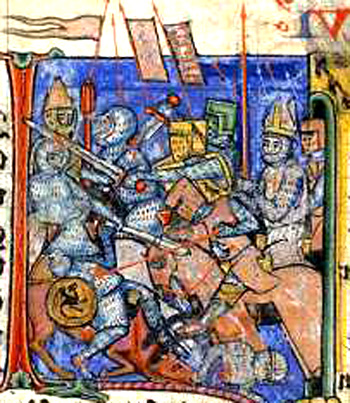Stories & Legends
 |
 |
 |
 |
 |
 |
 |
Order in the Medieval Battle
In battle it was vital that combatants cooperated.
William Marshal's biographer summarizes the situation with the phrase ‘fols est qui trop toste se desroté’ – a man who breaks ranks too early is a fool.’
The Rule of the Knights Templar gives clear instructions on how its members were to conduct themselves on the field. And while both they and the Hospitallers, whose regulations were very similar, might have a more formal discipline and structure by dint of being a monastic order, they must surely have been based on practices common to knightly forces.
 Once in his eschielle, or squadron, no brother knight was permitted to charge or leave without permission of the Marshal, who alone gave the command to charge. Nor was he to turn his horse’s head to the rear to fight or to shout.
Once in his eschielle, or squadron, no brother knight was permitted to charge or leave without permission of the Marshal, who alone gave the command to charge. Nor was he to turn his horse’s head to the rear to fight or to shout.
The only exception of this was that a brother might leave the ranks to adjust his saddle or, if he saw a fellow knight who 'acts foolishly, and any Turk attack him in order to kill him, and he is in peril of death,’ then he might go to his aid. This reinforces the idea that those who rode out alone were behaving rashly. As soon as he had accomplished this mission, the Templar was to return quietly to his place in the ranks.
Once engaged, no brother was to leave the field without permission, even if wounded, on pain of being expelled from the Order.
Thus the knight fought not as an individual but as part of a small unit – the eschielle of the Rule of the Templar Knights, or similar units called conrois or constabularii – of anywhere between 10 and 50 men, who supported each other in battle.
In the Rule the squadrons were formed around a commander and banner, the knights attacked 'in front and behind, to the left and the right, and wherever they thought they could torment their enemies so long as they were able to protect their banner.'
A similar structure underpinned the conrois and familiae of other knights. ...
Disorder in the attack turns into defeat
Orderic Vitalis tells us that the French launched the first fierce charge against the Anglo-Normans at the Battle of Brémule, but ‘charging in disorder, they were beaten off and, quickly tiring, turned tail.’
This analysis is supported by Orderic's contemporary, the French Abbot Suger. He says of the same French attack that they ‘were in disorder, and fell upon the extremely well ordered and smartly formed troops. As happens in such a case, they could not withstand the controlled pressure of the enemy, and beat a hasty retreat.’ ...
In another example, it was disorder amongst the troops of the Holy Roman Emperor, who pursued the French force too quickly and lost their cohesion, that was a prime cause of their defeat at the Battle of Bouvines in 1214.
The ideal cavalry charge
The ideally conducted charge saw the squadrons formed up in dense order, ‘so tightly packed,’ say a number of sources, ‘that a gauntlet could not fall between them.’ Then they advanced steadily so that all arrived against the enemy together and, through sheer weight and impetus, broke their line and put them to flight.
 This did not always happen. Perfecting the timing of a charge was a very difficult thing to achieve. If the enemy held, or even if they fled, the impetus of the charge would wane and the cohesion of the squadron would break down, at which point the knights would become vulnerable to counter-attack.
This did not always happen. Perfecting the timing of a charge was a very difficult thing to achieve. If the enemy held, or even if they fled, the impetus of the charge would wane and the cohesion of the squadron would break down, at which point the knights would become vulnerable to counter-attack.
William of Tyr relates how, after driving off a large force of Saracens during an engagement in 1179, the knights of Baldwin IV of Jerusalem set to looting the field. The main body of the Muslim army reappeared and then:
“When the knights saw the enemy, whom they had considered defeated, streaming in their direction with renewed strength, they had neither time nor opportunity to form up their units and get into position according to military discipline. They fought in disorder, offered resistance for a time and withstood the onslaught bravely. But in the end the odds were too much against them, because they had to fight spread out and in disorder, and could not help each other. They were shamefully put to flight.”
Thus, we see how important was to keep order and discipline in the units of medieval chivalry.


William Marshal's biographer summarizes the situation with the phrase ‘fols est qui trop toste se desroté’ – a man who breaks ranks too early is a fool.’
The Rule of the Knights Templar gives clear instructions on how its members were to conduct themselves on the field. And while both they and the Hospitallers, whose regulations were very similar, might have a more formal discipline and structure by dint of being a monastic order, they must surely have been based on practices common to knightly forces.

English cavalry on march - a perfect order in formation
The only exception of this was that a brother might leave the ranks to adjust his saddle or, if he saw a fellow knight who 'acts foolishly, and any Turk attack him in order to kill him, and he is in peril of death,’ then he might go to his aid. This reinforces the idea that those who rode out alone were behaving rashly. As soon as he had accomplished this mission, the Templar was to return quietly to his place in the ranks.
Once engaged, no brother was to leave the field without permission, even if wounded, on pain of being expelled from the Order.
Thus the knight fought not as an individual but as part of a small unit – the eschielle of the Rule of the Templar Knights, or similar units called conrois or constabularii – of anywhere between 10 and 50 men, who supported each other in battle.
In the Rule the squadrons were formed around a commander and banner, the knights attacked 'in front and behind, to the left and the right, and wherever they thought they could torment their enemies so long as they were able to protect their banner.'
A similar structure underpinned the conrois and familiae of other knights. ...
Disorder in the attack turns into defeat
Orderic Vitalis tells us that the French launched the first fierce charge against the Anglo-Normans at the Battle of Brémule, but ‘charging in disorder, they were beaten off and, quickly tiring, turned tail.’
This analysis is supported by Orderic's contemporary, the French Abbot Suger. He says of the same French attack that they ‘were in disorder, and fell upon the extremely well ordered and smartly formed troops. As happens in such a case, they could not withstand the controlled pressure of the enemy, and beat a hasty retreat.’ ...
In another example, it was disorder amongst the troops of the Holy Roman Emperor, who pursued the French force too quickly and lost their cohesion, that was a prime cause of their defeat at the Battle of Bouvines in 1214.
The ideal cavalry charge
The ideally conducted charge saw the squadrons formed up in dense order, ‘so tightly packed,’ say a number of sources, ‘that a gauntlet could not fall between them.’ Then they advanced steadily so that all arrived against the enemy together and, through sheer weight and impetus, broke their line and put them to flight.

Bishop Adhemar de Monteuil,right, takes part in a cavalry charge in the First Crusade
William of Tyr relates how, after driving off a large force of Saracens during an engagement in 1179, the knights of Baldwin IV of Jerusalem set to looting the field. The main body of the Muslim army reappeared and then:
“When the knights saw the enemy, whom they had considered defeated, streaming in their direction with renewed strength, they had neither time nor opportunity to form up their units and get into position according to military discipline. They fought in disorder, offered resistance for a time and withstood the onslaught bravely. But in the end the odds were too much against them, because they had to fight spread out and in disorder, and could not help each other. They were shamefully put to flight.”
Thus, we see how important was to keep order and discipline in the units of medieval chivalry.

Excerpt from Robert Jones, Knight: the Warrior and World of Chivalry,
NY: Osprey Publishing, 2011, pp74-76
Posted April 27, 2013
NY: Osprey Publishing, 2011, pp74-76
Posted April 27, 2013






